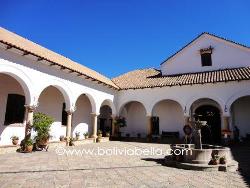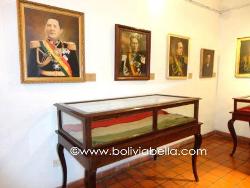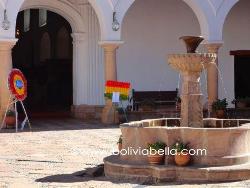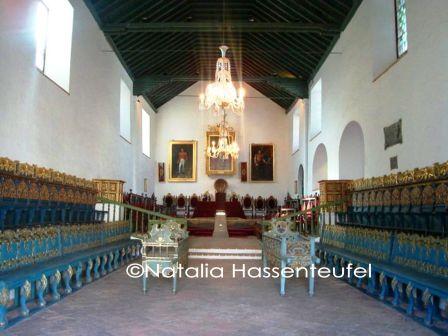|
Casa de la Libertad in Sucre Bolivia The Casa de la Libertad, in Sucre, Bolivia, is roughly equivalent to America's Independence Hall in Philadelphia. It is here that Bolivia signed its Declaration of Independence from Spain, drafted its first Constitution and laws, and named Sucre, its first city, the capital of Bolivia.
The Casa de la Libertad used to be a university, established by the Jesuits who came from Spain to evangelize to the natives of the region (they were eventually expelled). Some of the main protagonists of the battles that ended in Bolivia's independence (between 1809 and 1825) were graduates of the university. The structure was built before 1700 by the Compañía de Jesus, a Jesuit order of the Catholic Church, to be used as the San Francisco Xavier University. True to the traditional construction style of the time, it has many ample rooms (which were used as classrooms) built in a square that surround an inner courtyard. The galleries (hallways) have many columns and arches, its doors are made from cedar, and the at the rear is what used to be the chapel, complete with intricately carved choir chairs. It also has a large salon called the Sala Mayor which was used for the most important academic events.

Soon after the War of Independence had ended, the assembly of deputies from the five provinces of the Viceroyalty of Altoperu were summoned by Mariscal Sucre to meet in July 1825 to deliberate over the new nation's future. The assembly decided to declare independence on August 6, 1825 and the new Republic of Bolivia was founded with Sucre as Bolivia's Capital and first city. Between 1825 and 1898 the Bolivian Congress met in this building. Here, the first Bolivian Constitution, drafted by Simón Bolivar, was approved as were the fundamental laws of the new country. Here Mariscal Sucre was sworn in as the first president of the Republic of Bolivia, as were other presidents after him. This is a great YouTube video that shows the interior of the Casa de la Libertad. It's in Spanish but you'll be able to see most of the rooms and courtyard: https://youtu.be/qzfIBxyf7AY When the Legislative and Administrative branches of the government were physically moved to the city of La Paz, the Casa de la Libertad became a repository for historical relics, busts of the people who forged the history of Bolivia, some incredible collections of documents, newspapers, and hundreds of maps, some of them over 300 years old. There is also a library (la biblioteca) filled with very important historical and geographical documents that have been purchased and collected over the years. It has a book library, a map library, a brochure library, and national historical archives.

What used to be the Jesuit chapel is now called the Salón de la Independencia (first picture above). It is considered to be one of Bolivia's most important examples of Colonial architecture, given more importance by the fact that the nation was freed and established here. This is the most important hall in the structure. The Bolivian Congress convened in this hall through 1898. It is also the most elaborate room in the structure. Here you can see a throne that used to belong to the Archbishop of La Plata, and the Congressional Chairmen after him. The Jesuit Chapel had a beautiful painted ceiling dating back to the 1600's and above, protruding from the wall, there is an elaborately carved wooden choir loft that is over 300 years old. Bolivia's Declaration of Independence is kept here under an airtight glass case. It is Bolivia's most valuable document. The Casa de la Libertad has seven such halls, each now featuring various types of antiques and historical documents or relics. Another of the most important of these is the Galería de Presidentes (Hall of Presidents) which is where the Senate used to convene. Here you'll find paintings of Bolivian presidents from Mariscal Sucre, Bolivia's first president, to Evo Morales, along with flags, sculptures and busts, and some of the personal belongings of various past presidents.

The Casa de la Libertad is open to the public from Tuesday to Saturday from 9:00 a.m. to 12:00 noon and from 2:30 to 7:00 p.m., and on Sundays from 9:00 a.m. to 12:00 noon. Bolivian nationals pay Bs. 10 to enter and foreigners pay Bs. 15 to enter. Photography is prohibited inside the Casa de la Libertad. If you want to take pictures, you must approach the guard who is stationed at a desk just to the right of the entrance and request a photography permit, which will cost you Bs. 10. Phone: (591-4) 645-4200 or 645-2690 Email: cdl@casadelalibertad,org.bo Website: www.casadelalibertad.org.bo Click here to read more about the History of Sucre the Capital of Bolivia     |
